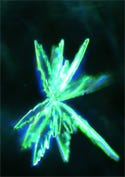March 7, 2007
Originally Published MPMN March 2007
EMERGING AND NANOTECHNOLOGIES
Researchers Create Stretchy and Strong Polymeric Nanocomposite
|
This micrograph taken under cross-polarized light shows the results of stretching the nanocomposite. |
Scientists have repeatedly encountered a stumbling block while trying to develop a material that is both stretchy and strong. For a polymeric composite to be stiff, it typically requires the inclusion of a hard filler material; however, the hard filler often inhibits polymer flexibility. As a result, most materials are either stretchy or strong—seldom both.
But a recent development has enabled a team of scientists to clear this materials science hurdle. Researchers from the Massachusetts Institute of Technology (MIT; Cambridge, MA; www.mit.edu) have modified a polyurethane to produce a polymeric nanocomposite that is both stretchy and strong. Owing to its strength and minimal exhibition of creep, the material could replace some polyurethanes in biomedical devices. Potential uses for the material include stents, prosthetics, and artificial organs.
|
Bright, recrystallized domains reappear in the nanocomposite when the sample temperature is held at 60°C for several days. |
Working at the university’s Institute for Soldier Nanotechnologies, professor Gareth McKinley, mechanical engineering graduate student Shawna Liff, and postdoctoral researcher Nitin Kumar embarked upon the research with the intent of developing a tear-resistant fabric for military uniforms. The goal was to create a strong and tough—yet breathable—material, according to Liff.
Taking a cue from nature, the researchers mimicked the makeup of one of the few materials that has both properties. Famously strong and flexible, spider-spun silk derives its unique characteristics from the arrangement of beta sheets, or nanocrystallites, that reinforce the flexible fiber. “It’s essentially a natural polymeric nanocomposite,” observes Liff.
The team sought to similarly reinforce a commercial polyurethane elastomer on the nanoscale, introducing nanocrystallites, in this case nanosized clay platelets. “The idea of making a nanocomposite, particularly using clay, is not a new idea,” Liff explains. “The trick was finding a process that could disperse [clay] platelets really well and keep them dispersed, even in the polymer.”
By implementing a solvent-exchange approach, Liff and her colleagues achieved this goal. The researchers embedded clay platelets in a thermoplastic by dissolving the platelets in water and then slowly exchanging water for a second solvent that dissolved the polymer. After the polyurethane was dissolved, the solvent was removed until only the polyurethane-clay nanocomposite remained. The resulting nano-composite was strengthened by the distribution of the stiffened clay platelets, but retained the flexibility of the original polymer.
Copyright ©2007 Medical Product Manufacturing News
You May Also Like




